When planning a trip, we always try to go off the beaten track and explore places that have been hitherto overlooked. Hence, when it was time to visit Goa; probably the most over-exposed destination in whole of India; I desperately tried to find a side of Goa that is still untouched. Some research led me to Chandor, a lush village 15km away from Margao. I was intrigued when I read about it’s string of colonial-era mansions belonging to Goa’s former landowners who found favour with the Portuguese aristocracy.
Once in Goa, I spent the first few days doing the usual touristy circuits of beaches, beach shacks and churches but I always had Chandor at the back of my mind. One afternoon, chatting with the owner of my home stay; a matronly Goan Catholic lady staunchly critical of Goa’s transformation from an idyllic coastal haven to a raucous party; I broached the topic of visiting Chandor. Her eyes lit up as she told me about how she too had never heard about the place till she visited it a few years ago with some of her overseas guests. In an excited tone she went on to tell me about palatial houses older than the Taj Mahal, closets with hidden escape passages, dressers with secret compartments and curios from all over the world.
So, the next morning, armed with instructions from the matron of the house, I set off towards Chandor. An hour and a half, a bike taxi and two bus rides later, I arrived in Chandor around lunch time. The conductor of the bus from Margao to Chandor had remarked on seeing on my big camera and straw hat, “Bade ghar jaana hai? (You want to go to the Big House?) Braganca House?” Recognizing the name from my conversation with my homestay owner, I had nodded along. Dropping me off in front of the white-washed church in the center of the village, he pointed across the road and uttered, “There it is” just as the bus revved up and went scooting round the corner.
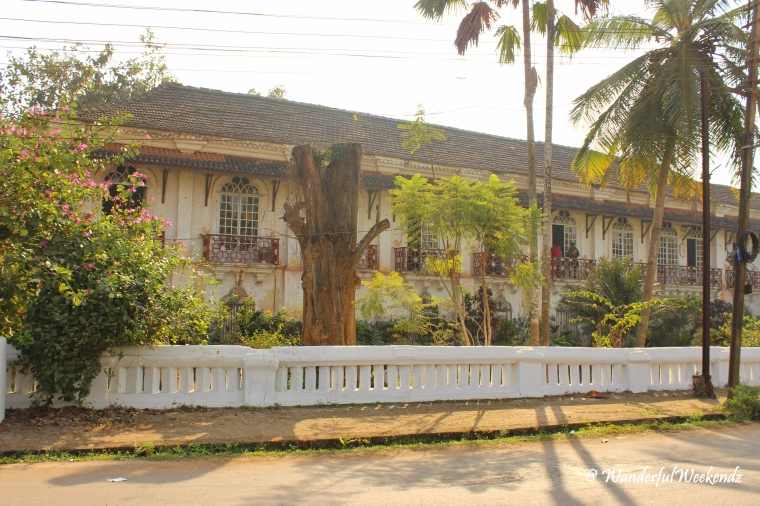
Across the road was a longish two storied rectangular building with tiled roof. If not for it’s French windows with tiny hanging balconies, I would have mistaken it for a warehouse. The upper left half of the house seemed abuzz with activity – the laughter and friendly banter suggested an on-going house party. Walking in through the unkempt garden, I did not notice any entrances on the ground floor so I directly went up to the first floor. The first floor landing had two towering wooden doors next to each other. One of them was open and the smell of biryani came wafting through – the on-going party. I thought it best not to go in there. The second door, shut tight, had a shiny bronze plate with the name “Menzes Braganca” embossed on it.
I had assumed these houses to be like those of Chettinad, where the owners had long moved abroad leaving them in care of housekeepers but it now occurred to me that that was not the case here. These houses were still family homes and not abandoned mansions bemoaning their past grandeur.
I suddenly felt like an intruder but I had come too far to go back from the doorstep. Mustering up some courage, I gently rapped on the door. It was a while before someone finally answered. A maid. I told her that I had come from Panjim to see the house. She asked me to wait in the living room with painted green walls and ornate furniture that had tell-tale signs of time. I was admiring the blue pottery and fading framed photographs in the room, when the maid returned and said, “Madam is resting. I will show you around. It will be Two Hundred Rupees”. I said ok. She took me along from one room to another. Chairs, tables, chandeliers, four poster beds, crochet bed spread woven by her madam and we were back at the main door before you can even finish counting to Two Hundred. I felt woefully deprived. Turning around, I requested to see the grand chandeliers in the ballroom once again. She didn’t seem happy about spending more time with me but obliged. This time I took it slow, admiring the way the light scattered through the chiselled crystal to cheer up the stained walls and the worn out floor and ceiling of the ballroom; the frivolous loveseats in the corridor that doubled up as the reading room and the crystal and silverware in the dining room showcase.
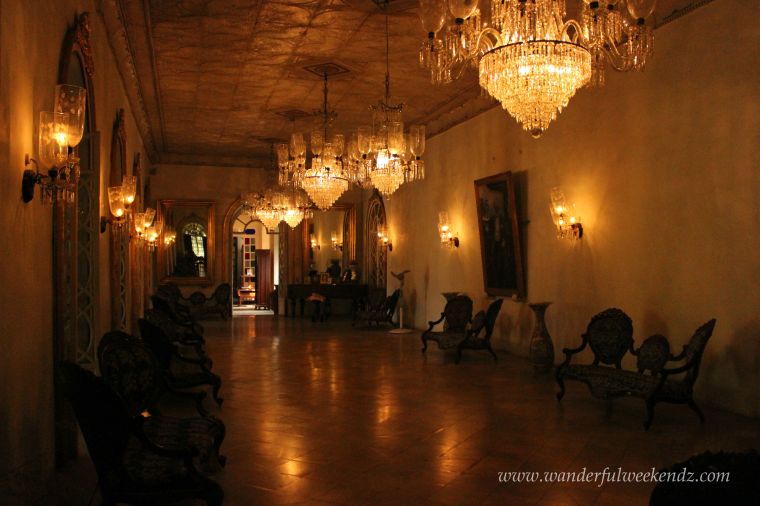
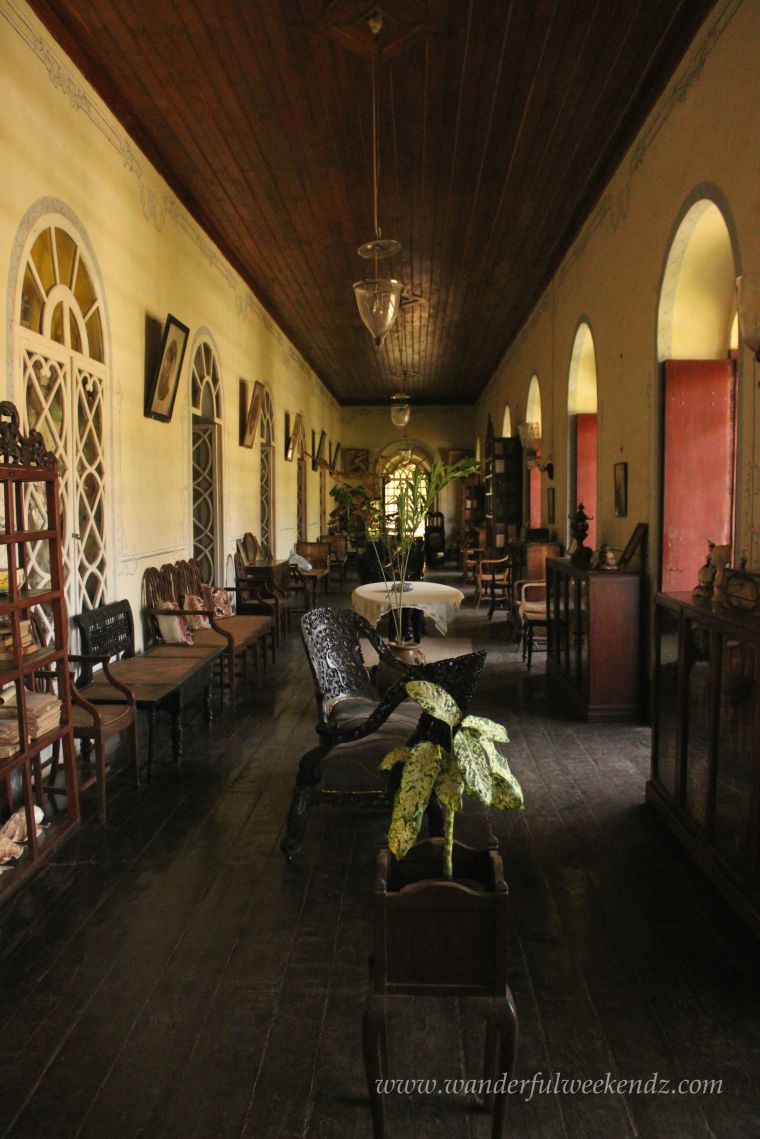
Emboldened by this experience, I decided to pop my head into the adjacent door and try my luck. A man answered my call, only to disappear into the house and then reappear with a stooping but strong elderly lady with short silvery hair – the lady of the house. After the inquiring about my whereabouts, she started taking me around the house, stopping every now and then in front of happy family pictures and showcases filled with curios, old and new. I now realized that what I had assumed to be a house party, was actually a movie shoot in progress. The grand ballroom, the location for the shoot, was strewn with spotlights and other photography equipment. One of the bedrooms had been transformed into a changing room for the actors.
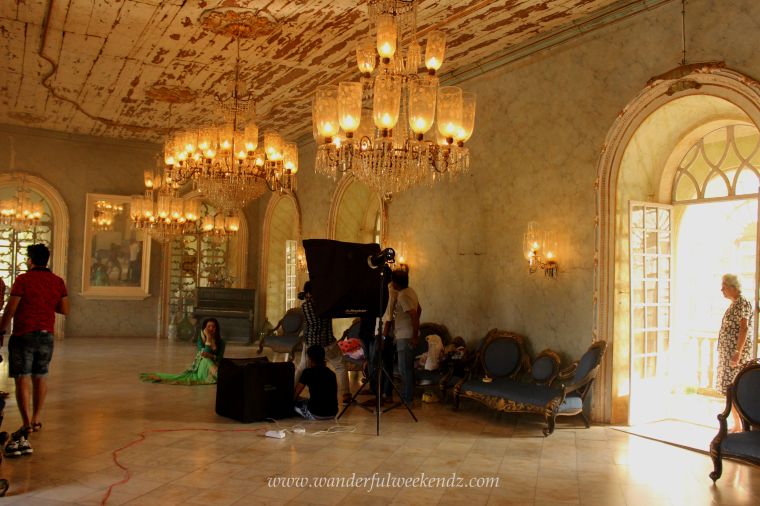
I followed the matron from one room to another as she showed me ornate arm chairs which were a gift from the King of Portugal, the family’s coat of arms painted on the exterior of the house, the faraway resting place of their ancestors visible from one of the windows, the rusting green Allwyn fridge which used to run on diesel when it was first purchased in the 1950s because there was no electricity in Chandor then and the small chapel inside the house that houses a nail of St. Francis Xavier. This half of the house was less grandiose than the former. Here expensive showpieces mingled happily with plastic toys and cheap seashell curios from trips to the beach – a tell-tale sign of habitation but the company of the matron of the house made the tour much more intriguing. We ended the tour in the living room, where we had begun. I shook her hand to say thanks and that was when she told me her name, “Mrs. Aurea Menzes Pereira”. It made sense then. This is the Braganca Pereira House – one house inhabited by two branches of the same family.
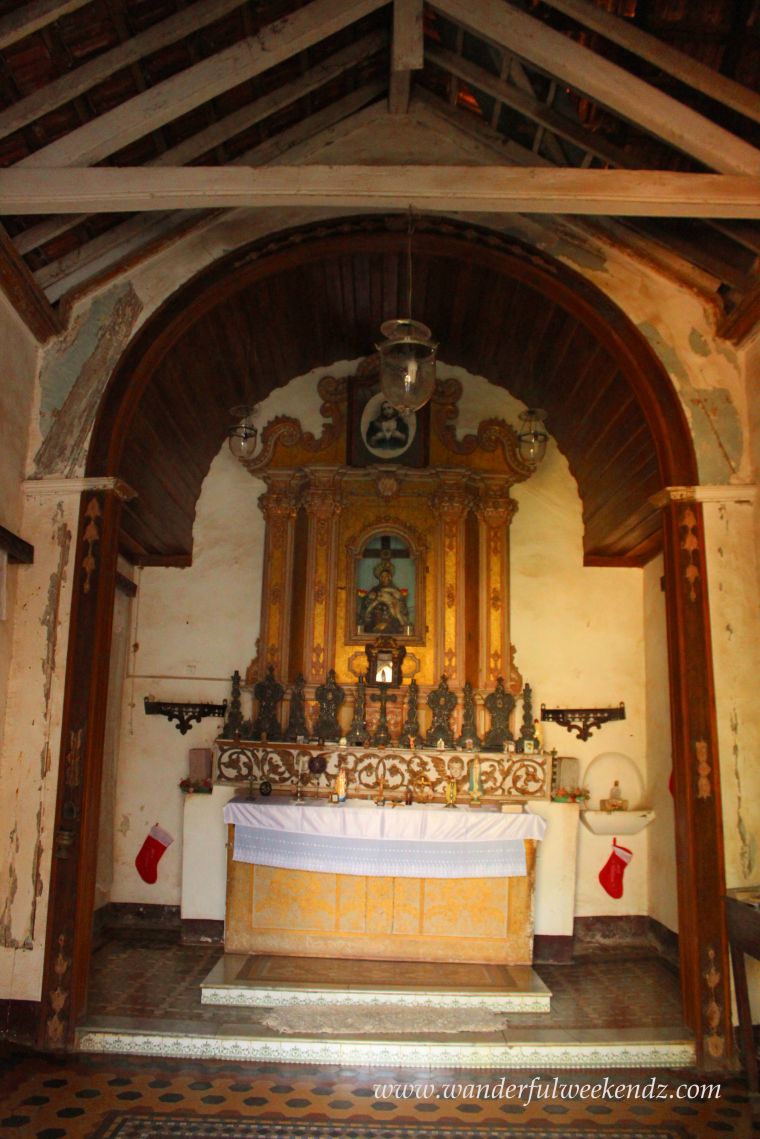
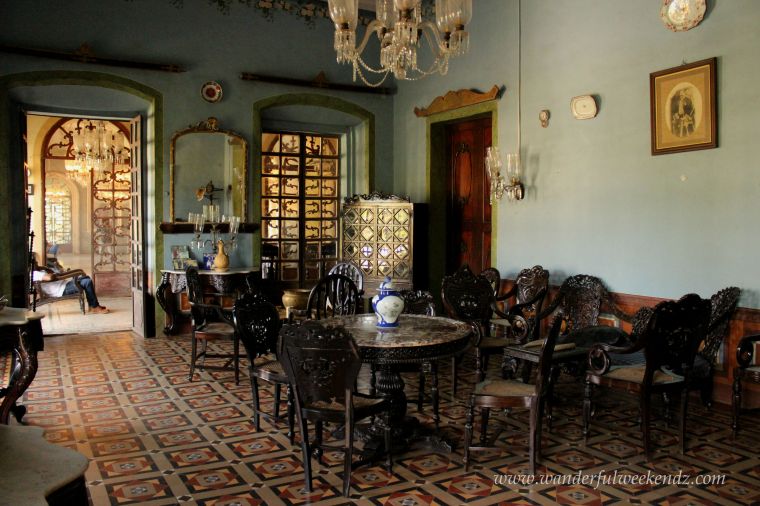
It was Mrs. Aurea Menzes Pereira who told me about the third heritage house in Chandor – the Fernandes House. Though on a straight road from the Braganca House, it took me a few false starts to get there primarily because nobody around the village of Chandor seemed to know about it even though they all genuinely wanted to help me find the Fernandes House. It was finally a woman waiting outside her home for a bus to Panjim, who caught hold of her milkman and had me dropped there.
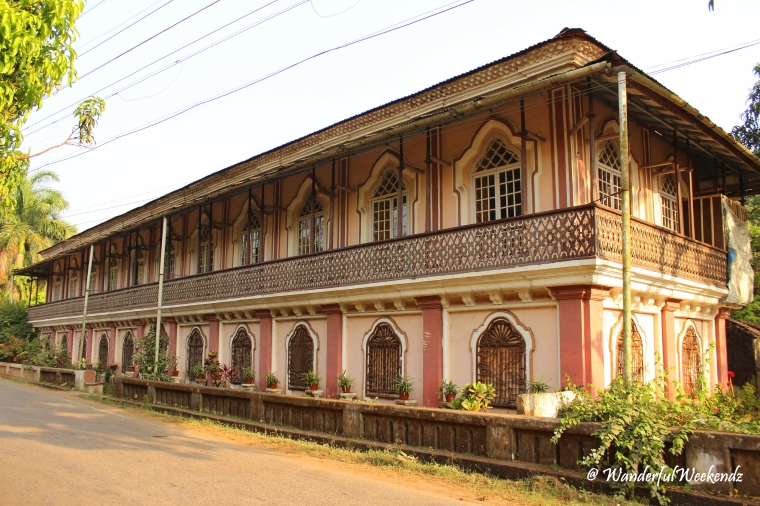
I pressed the bell taped to the door facing the main road and waited for someone to open the door. A minute, two minutes, five minutes passed. No answer. I tried the bell again. The house seemed absolutely still. I stepped back trying to spot an open window or any sign of movement. The glass windows on the upper floor were shut tight and so were the oyster shell windows on the ground floor. Some of the oyster shells in the ground floor windows had fallen off due to lack of upkeep revealing nothing but pitch darkness inside the house. I was about to give up and leave when I heard someone shouting from upstairs. One of the windows on the upper floor had flung open and a young man was peering out asking me to wait. He was down in a jiffy but when he opened the door, I realized that he was not young at all. Though short and slim built, his grey hair clearly conveyed that he was middle aged at least. The man seemed to have guessed my purpose of visit and let me in without asking for introductions.
The ground floor was dark, musty and seemed completely uninhabited. There was not a sound in the whole house. The setting eerily reminded me of American horror movies. I hesitated for a moment, wondering if I should turn back now but the man had started talking. “Here are some palanquins to carry priests and members of the family. This house is about 500 years old.” I did not take out my camera just so I can be ready to flee in case of any untoward eventuality. He went on to show me an almost unrecognizable sculpture of the Hindu god Ganesha, a Shiv Linga and several other artifacts from a pre-Portuguese era temple that used to stand next to their house. There were some framed photographs of men in veshti (a sort of white sarong) and turban performing what looked like a Hindu prayer ritual. He explained that his ancestors were Hindus once but they converted to Christianity about 400 years ago. However, even after embracing Christianity, the family did not discontinue some of the Hindu rituals that they used to patronized. This was a picture of Hindu priests performing one such ritual in the grounds of their house. My fear was being replaced by my surprise over his candidness. I don’t think I had even come across a better example of secularism and to think that this family has been doing this since before even the concept of secularism came into existence, left me in awe.
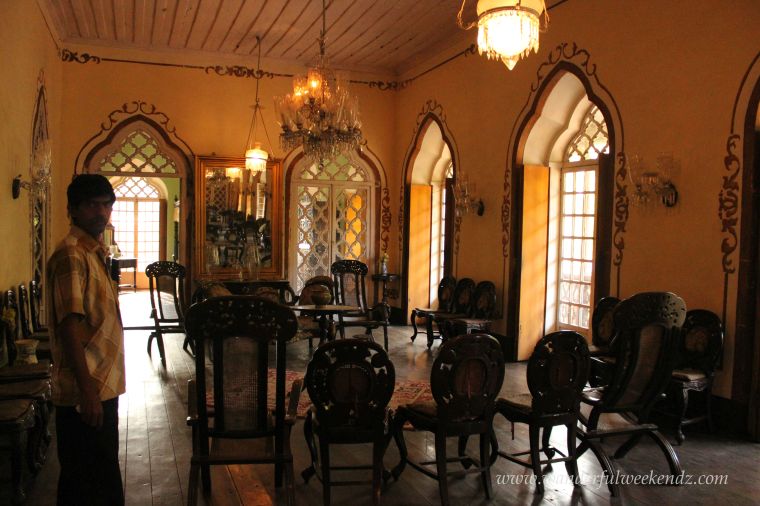
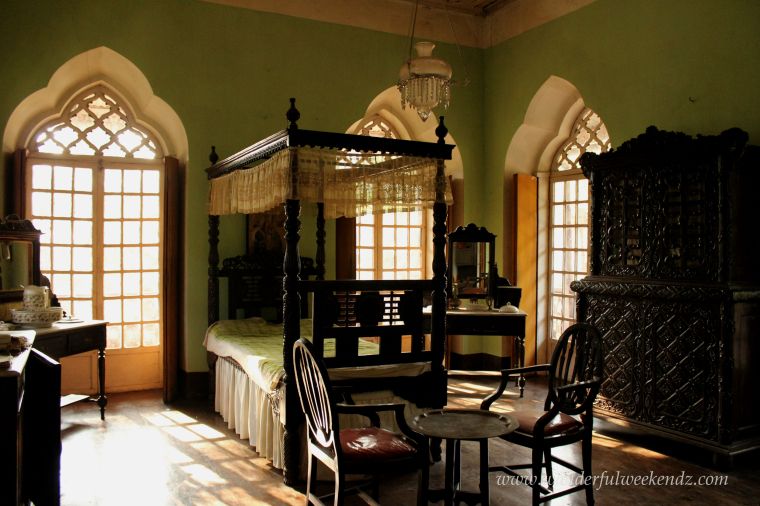
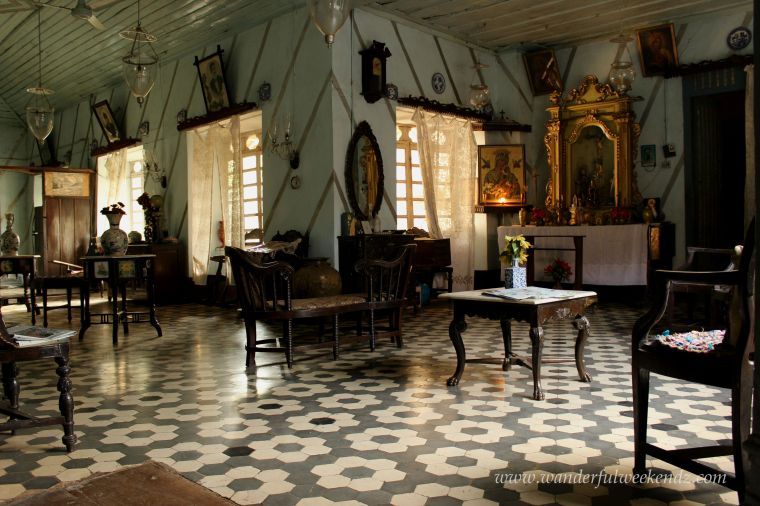
The first floor of the house was markedly different from the ground floor in style and essence – elegant with wooden floor, crystal chandeliers, intricately carved furniture and fading European photographs on the walls. I finally relaxed enough to pull out my camera and take pictures. Walking through the living room to the sunlit bedroom, my host was getting animated now. Stopping in front of a carved dresser, he started pressing invisible buttons and levers to reveal secret compartments to store jewelry and valuables. Speaking to him, I came to know that around nine members of the Fernandes family; including the matron Mrs. Sara Fernandes, her sons, daughter-in-laws and grandchildren; still live in the house. He himself was the youngest son of the matron.
Next we went to a small unkempt room adjacent to the living room. There was an old unremarkable closet in one corner and a stack of papers in the other corner. I had started wondering as to what was to be seen here when my host opened the closet and said with the flair of a magician presenting his best trick, “This is walk-in closet for dressing up” and then he suddenly bent down and lifted the wooden panel on the floor of the closet and declared, “And a secret escape passage in case the house is attacked by enemies”. A step closer revealed, a flight of stairs descending below. My host descended first, with me in tow. The passage was no more than an underground room now but once it served as a swift escape for family members to the waiting boats in the river that flows a few metres away from the house. Hair raising, to say the least.
Once done, the gentleman asked me leave my comments in their visitor book. As I turned the pages, I noticed that most of the people who had signed in it were foreigners. The page I signed on, had comments of visitors from UK, Russia, Norway, France, South Africa and Portugal but there was only one other visitor from India. I asked my host if many Indians come to visit Chandor and it’s heritage homes to which he nodded his head and said, “Not many. Most Indians who visit Goa, don’t venture beyond the beaches.” Such a pity. Wish more of us take some time out to explore the Goa beyond the crowded beaches and noisy parties. The lush idyllic Goa with simple and friendly people that still exists beyond the tourist circuit.
Getting there and around:
Chandor is about 40 kms away from Panjim. If you wish to take the public transport to get there, take a bus from Panjim to Margao and then change over to a bus for Chandor at Margao. Buses from Panjim to Margao are pretty frequent. However, between Margao and Chandor, there is one bus every hour.
The village of Chandor is small enough to cover on foot.
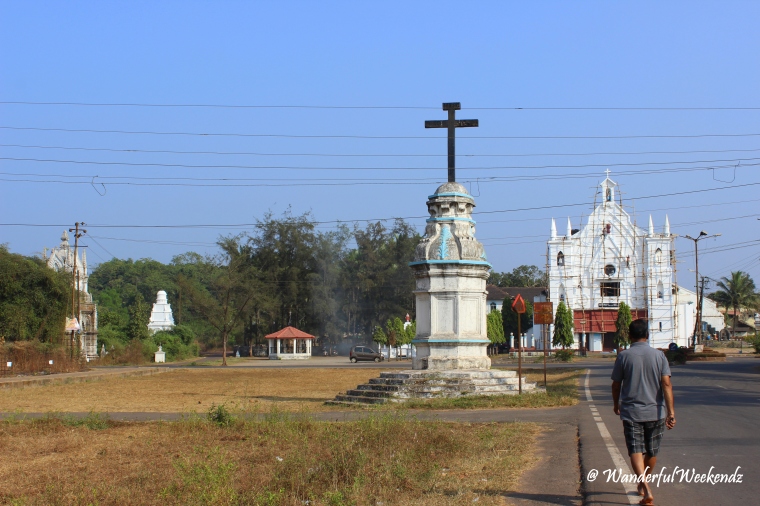
Where to Eat:
I failed to spot any restaurants in Chandor and survived to trip on some fruits that I had purchased at the time of starting from Panjim. However, I recently came across a National Geographic article that spoke very highly about a little restaurant called Casa Bela in Chandor that is renowned for it’s rose flavored tea. If you can find it, let me know how the food tastes!
That’s all for now fellas!
Happy Exploring!
For more weekend wanderings, follow us on:


Loved it ….. I guess I am one of the very few people who do not have Goa listed high on their “To Travel” list. When I do take a trip to Goa, I would prefer to explore the offbeat & unexplored side 🙂
Chandor looks magical and grand. How I love the antique furniture and chandeliers ….. superb!
LikeLiked by 1 person
I am one of those too who didn’t have Goa on top of their travel list but Chandor and a few other places in Goa got me interested. Check out Dudhsagar Falls too. I could not visit it in my last trip but soon maybe….
LikeLiked by 1 person
Lovely info. During my project on traditional Gian houses I just could not locate these two gems. Now I will go to both. But it feels like having seen due to your good description.
LikeLike
Thank you. Yes you must visit both of them. Pictures and descriptions just don’t do justice to their beauty. 🙂
LikeLike
This is way beyond beautiful! It takes real guts to talk about Goa without a single beach shot. Loved the Goan bed shot you have clicked. I want one for my home. Also May i add, the beginning of your blog, the cover picture if I may say it, with multiple fragments of Indian culture is cool too!
LikeLiked by 1 person
Thanks for your kind words. I am glad that you like the pics.
The truth is that there is so much to Goa than the beaches and the aim of WanderfulWeekendz is to highlight such lesser known aspects of well known destinations.
If you enjoyed reading this, you will surely also like https://wanderfulweekendz.com/2016/12/24/impressions-of-a-first-time-solo-traveler-to-goa/
Cheers!
LikeLiked by 1 person
Sure, I will check this out.
LikeLike
A fascinating read! Beautifully captured in words and images. Shall bookmark to ensure a visit sometime! Thank you,
LikeLiked by 1 person
Awesome. Glad you enjoyed reading it.
LikeLike
Wow.. Amazing place.. Thanks for sharing the post.. Loved reading about it,.
LikeLiked by 1 person
Glad you enjoyed reading this. 🙂
LikeLiked by 1 person
We had planned to visit Chandor last summer but couldn’t fit it in our schedule but I think the heritage houses in Chandor tops my list of things I want to return to Goa for. I’m from Calcutta so you know I have a soft spot for old houses. Thanks for the link to your post. Your photographs and those chandeliers are stunning, to say the least!
LikeLike
Thank you. Yeah Kolkata a treasure trove of beautiful old houses. Too bad that most of them are in dire need of maintenance. I am a Bangali too though not from Kolkata but every time I go there, I just gape at old buildings. Do let me know if any old houses in Kolkata are open to public like those in Chandler.
LikeLiked by 1 person
I think the best people to show you around old Calcutta houses would be the folks at Calcutta Walks. They recently restored a house from the 1920s near Shyambazar.
LikeLiked by 1 person
Oh ok. Thank you. Will check them out online. 🙂
LikeLike